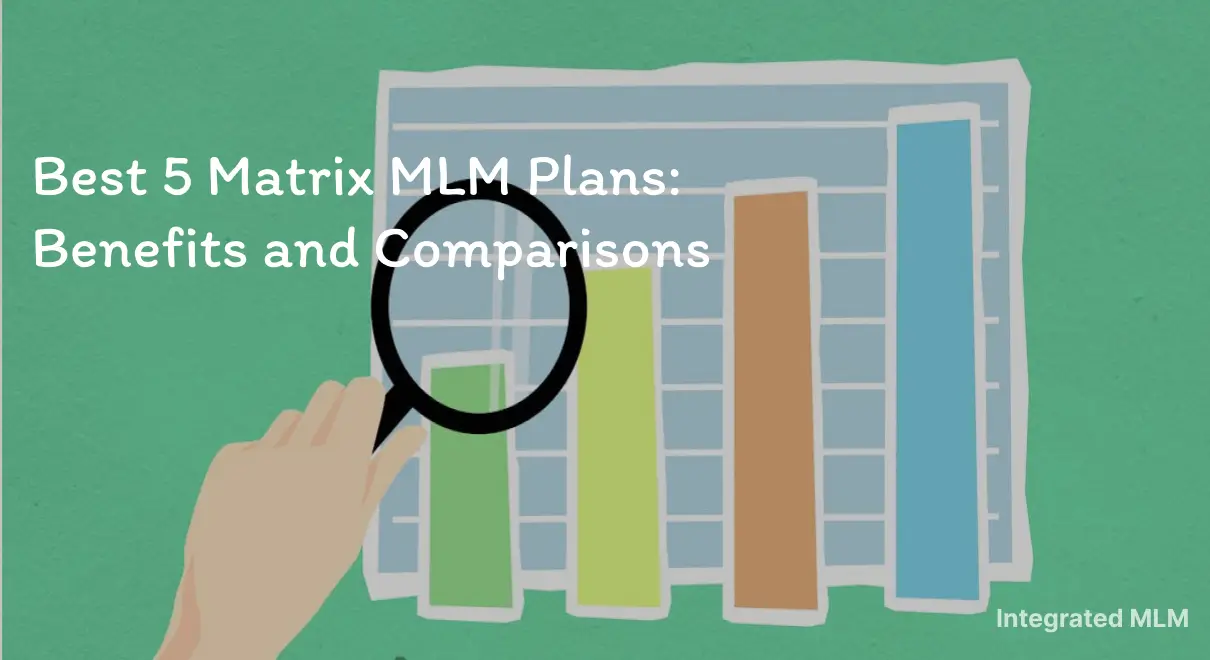The Matrix MLM plan is one among the most favourite compensation plans of the network marketing world. The organization structure is based on units of fixed width and depth. The placement can be forced or free depending upon the flexibility given to distributors to allocate themselves in the matrix.
This provides a well-defined structure, clarity regarding growth and an all-round support for the development of teams in contrast to the haphazard growth offered in the other compensation plans.
Table of Contents
Glossary of Key Terms
- Width: Width means the maximum number of placements of distributors that can be made in the first level. This is indicated by the first number in the representation of the Matrix. Eg. In a 3×5 matrix, 3 is the width.
- Depth: It means the number of levels considered for compensation in the Matrix. In a 3×5 matrix, 5 is the depth of the matrix.
- Forced Matrix MLM Plan: When the newly recruited members of the matrix are placed automatically in the available spots under the sponsor, it is called Forced Matrix MLM Plan.
- Auto Matrix Plan: When the newly recruited members are given the choice to choose their placement in the matrix, it is called Auto Matrix MLM Plan.
- Spillover: The surplus members are the members whom the sponsor wants to recruit in their direct downline but are unable to recruit due to unavailability of positions.
- Cycling: The time taken by a sponsor or a distributor to complete their matrix is called Cycling Time. There are additional bonuses for a member for completing their downline.
- Compression: When the matrix compresses or collapses as the placements in the matrix is completed and new members are placed deeper in the structure.
- Flushing: The process of elimination of dormant or inactive members from the system. These new positions are allocated to new members.
- Rank advancement: As the distributors achieve higher ranks in the matrix, the bonuses, commissions and other benefits are unlocked for them. This is called rank advancement
- Unilevel MLM Plan: Matrix MLM plan type which allows the sponsor only one level of the matrix. In this model, the members have no width restriction. That is, it allows them to recruit as many distributors.
Top 5 Matrix MLM Plan Types
2×2:
This is one of the simple MLM plan types to understand. It allows 2 direct downline members and 2 direct recruitments by each member. The matrix would have a total of 6 members.
The simplicity and ease of managing this plan allows rapid growth for the organization. It is also easier to track and calculate compensation in this plan.
3×3:
The 3×3 model does not have much difference to the 2×2. It allows 3 direct downline members for the sponsor and 3 recruitments for each of them. The pattern repeats for another level. This would make up to 39 positions in the matrix.
The increase in width from the 2×2 MLM Matrix plan allows the 3×3 more earning potential. The downline activity itself can provide sizable income for the distributor.
3×2:
The 3×2 model is a shorter version of the 3×3 model. Here the sponsor is allowed 3 direct recruitments but the matrix is just 2 levels long. The total would be 13 members. The growth in this Matrix MLM plan type is more manageable. However, earning potential can be slower as compared to the 3×3 model.
3×9:
The 3×9 structure of Matrix MLM plan is a complex and large downline with only 3 members on their first level, each of whom would require a downline of 9 levels. The structure demands a stringent management of the downline along with an efficient sales strategy to enable the structure to provide the higher levels more earning potential.
5×7:
This MLM Matrix plan has 5 direct referrals to a depth of 7 levels. This results in a large matrix spanning over 7 levels and 78,125 positions. The earning potential of this matrix is massive due to its very size. However, managing the downline and team can be complex for beginners and requires experience and expertise.
Other Popular Matrix MLM Plans
3×7:
Each distributor gets 3 members for 7 levels. It offers manageable size with substantial earnings for a balanced growth.
4×7:
Each member gets 4 members for 7 levels. This is more complex than the 3×7 structure but comes with higher earning ability.
4×4:
There are 4 members in each distributor extending over four levels. The structure is simple and easy to manage allowing moderate growth and earning potential.
Advantages of Matrix MLM Plan
The matrix MLM plan or forced Matrix MLM plan allows the organization to choose their pace of growth and earning potential through the size of the matrix. A wide and deep network provides fast and rapid growth. Larger matrices also come with massive earning potentials for the distributors.
The flexibility of the matrix in terms of the structure and recruitment allows companies to adapt to changing market requirements. The number of matrices multiplies and scales in order for the businesses to expand rapidly.
Challenges of Matrix MLM plan
The major challenge of the types of Matrix MLM plan is the complexity in managing, understanding, training and supporting new distributors about the system and how it works. The larger matrix structures become hectic not only with the size but also the workload at each level.
The complex matrix structures can seem to be difficult to understand and create confusion between new recruits requiring constant training and support about the basic organizational structure. The high operational costs due to extensive training, support and management can prove to be more than other traditional MLM Plans.
Integrated Matrix MLM Software Solutions
In this case it is important to streamline the business operations to save valuable time by automating the routine tasks. The complex task of calculating commissions, especially for matrices with larger numbers of direct downline members or levels should not only be accurate but also less time consuming.
The usage of live-data and sales updates can help keep a track of sales activities without compromising the accuracy. All this and much more can be achieved by employing Integrated Matrix MLM software to streamline your Matrix MLM Venture.
The highly scalable, intuitive interface of the software grows up and down with your business model along with being easily adaptable for distributors from all backgrounds. The consistent support and extensive training provided for the distributors enables them to proceed with their day without concerning themselves about the accuracy of incentives or bonuses or the hassle of managing their schedules without a miss.
The Integrated MLM software and Super App enables them to be on top of everything with automated documentation, sales and bonus updates, scheduled reminders and a comprehensive dashboard for an extensive view of their performance. Book your free demo today to experience the ease of doing business yourself.
Conclusion
The Matrix MLM plan type continues to remain a favourite of distributors through their structured growth and earning potential. The smaller structures such as 2×2, 3×3, makes it easier for beginners to manage their MLM game without much risk and complexity.
The larger matrix structures are however suited for seasoned network marketers aiming for rapid growth and massive earnings. Based on all the requirements and unique needs of a company, a Matrix MLM plan type can surely be found to best fit the venture.
Frequently Asked Questions
What is a matrix MLM plan and how does it work?
A type of Matrix MLM plan consists of a distributor recruiting a fixed number of downline members for a fixed set of levels which determine the compensation for the distributor.
What are the benefits of a 2×2 matrix plan compared to other matrix plans?
A 2×2 plan is one of the most basic, easy-to-understand, scalable, and growth-oriented matrix MLM plans. It encourages higher team cohesion, synergy between distributors and ease of completion of cycling in order to get higher bonuses.
Why is a 5x7 structure advised to be opted by experienced marketers?
The 5×7 matrix structure opens up around 78,000 positions. Such a large marketing network is not only difficult to manage but also extremely challenging to optimize and strategize. Therefore, a few experienced hands-on boards are required to guide and grow such a network.
What are the key differences between the 2×2 and 3×3 matrix plans?
A 2×2 matrix plan requires 2 downline members who can recruit 2 other members each and in a 3×3, the width and depth becomes 3. Hence the primary and most important difference lies in its structure.
A 2×2 matrix has 6 positions to fill while a 3×3 matrix has 39 positions. 2×2 is quicker to complete and manage while a 3×3 is more complex but has higher earning potential.





